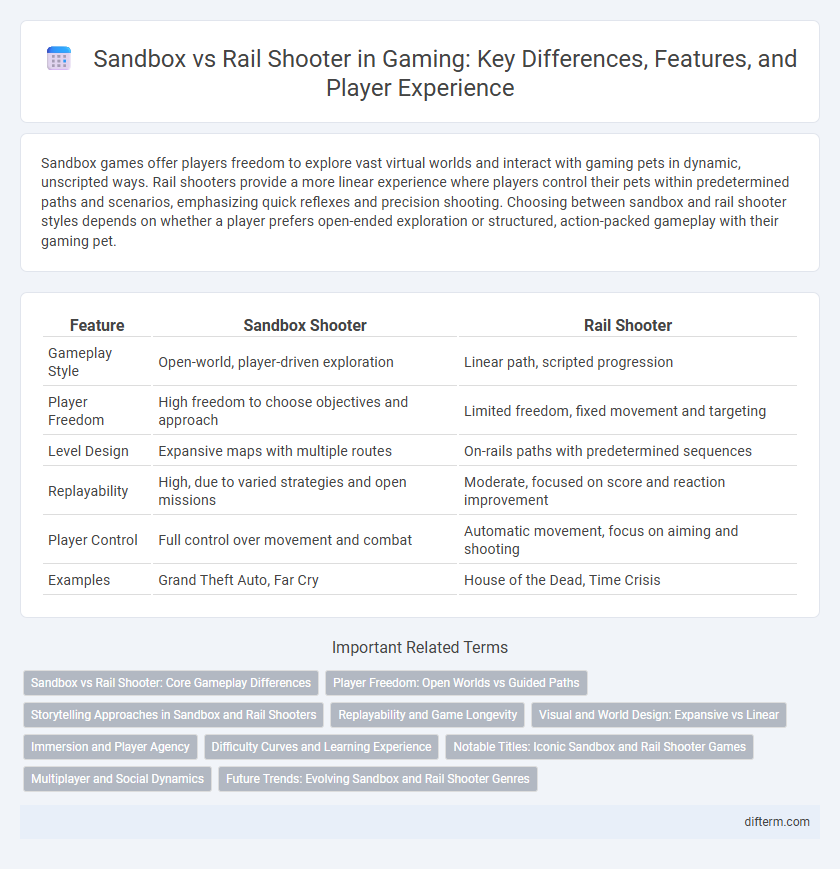Sandbox games offer players freedom to explore vast virtual worlds and interact with gaming pets in dynamic, unscripted ways. Rail shooters provide a more linear experience where players control their pets within predetermined paths and scenarios, emphasizing quick reflexes and precision shooting. Choosing between sandbox and rail shooter styles depends on whether a player prefers open-ended exploration or structured, action-packed gameplay with their gaming pet.
Table of Comparison
| Feature | Sandbox Shooter | Rail Shooter |
|---|---|---|
| Gameplay Style | Open-world, player-driven exploration | Linear path, scripted progression |
| Player Freedom | High freedom to choose objectives and approach | Limited freedom, fixed movement and targeting |
| Level Design | Expansive maps with multiple routes | On-rails paths with predetermined sequences |
| Replayability | High, due to varied strategies and open missions | Moderate, focused on score and reaction improvement |
| Player Control | Full control over movement and combat | Automatic movement, focus on aiming and shooting |
| Examples | Grand Theft Auto, Far Cry | House of the Dead, Time Crisis |
Sandbox vs Rail Shooter: Core Gameplay Differences
Sandbox games offer open-world exploration and player-driven narrative choices, promoting freedom and creative interaction within dynamic environments. Rail shooters provide linear, camera-controlled paths with scripted enemy encounters, emphasizing reflex-based shooting mechanics and quick decision-making. The core gameplay contrast lies in sandbox games fostering player autonomy and emergent gameplay, while rail shooters center on guided, fast-paced action sequences.
Player Freedom: Open Worlds vs Guided Paths
Sandbox games prioritize player freedom by offering expansive open worlds where exploration and choice shape the gaming experience, allowing players to interact with dynamic environments and narratives at their own pace. Rail shooters restrict movement along predetermined paths, focusing on fast-paced action and precise aiming, which limits player agency but enhances cinematic and controlled gameplay sequences. The contrast lies in sandbox games fostering emergent gameplay through open-ended exploration, whereas rail shooters deliver structured, immersive challenges through guided progression.
Storytelling Approaches in Sandbox and Rail Shooters
Sandbox games employ non-linear storytelling, allowing players to explore narratives at their own pace and make choices that influence the game's world and outcomes. Rail shooters deliver a more controlled narrative experience, guiding players through a predetermined path with scripted events and set-piece moments to intensify storytelling impact. The open-ended narrative freedom of sandbox titles contrasts sharply with the focused, cinematic storytelling of rail shooters, catering to different player preferences in interactive story engagement.
Replayability and Game Longevity
Sandbox games offer high replayability and game longevity through open-world exploration, player-driven narratives, and diverse mission structures that enable varied play styles. Rail shooters, with linear paths and scripted encounters, tend to have limited replay value as gameplay remains largely unchanged in subsequent playthroughs. The dynamic environments and emergent gameplay of sandbox titles sustain player engagement far longer than the fixed sequences typical of rail shooters.
Visual and World Design: Expansive vs Linear
Sandbox games feature expansive worlds with open-ended exploration, allowing players to interact with diverse environments and dynamic elements that enhance immersion. Rail shooters emphasize linear paths with tightly controlled visuals, guiding players through meticulously designed scenes that focus on pacing and cinematic presentation. The contrast in visual and world design shapes gameplay experiences, with sandbox games offering freedom and variety, while rail shooters deliver focused, intense action sequences.
Immersion and Player Agency
Sandbox games offer unparalleled player agency by allowing open-ended exploration and choice-driven narratives, enhancing immersion through dynamic world interactions and personalized gameplay experiences. Rail shooters limit player freedom by guiding movement along predetermined paths, focusing on fast-paced action but reducing the sense of control and deep engagement. Immersion in sandbox games stems from the freedom to shape the environment, whereas rail shooters rely on cinematic pacing and scripted events to engage players.
Difficulty Curves and Learning Experience
Sandbox games offer a nonlinear difficulty curve that adapts to player exploration and skill progression, promoting a personalized learning experience through trial and error. Rail shooters present a linear difficulty curve with controlled pacing, enabling players to focus on mastering specific mechanics in a guided environment. The contrast in difficulty design influences player engagement, where sandbox games emphasize strategic freedom while rail shooters prioritize reflex-based skill refinement.
Notable Titles: Iconic Sandbox and Rail Shooter Games
Iconic sandbox games such as Grand Theft Auto V and Minecraft offer expansive open worlds that encourage player creativity and exploration without linear constraints. In contrast, rail shooters like Panzer Dragoon and Time Crisis provide tightly controlled pathways and scripted enemy encounters, optimizing fast-paced, reflex-based gameplay. These notable titles exemplify the core design philosophies that distinguish sandbox freedom from rail shooter focus on precision and timing.
Multiplayer and Social Dynamics
Multiplayer sandbox games foster expansive social dynamics by enabling players to freely explore, build, and interact within open-world environments, promoting cooperative strategies and emergent gameplay. Rail shooters, with their on-rails movement, limit player autonomy but emphasize fast-paced, synchronized multiplayer action, often relying on team coordination for shared objectives. The contrasting player agency in sandbox games versus the guided progression in rail shooters shapes distinct community experiences and social engagement levels.
Future Trends: Evolving Sandbox and Rail Shooter Genres
Sandbox games are increasingly integrating procedural generation and AI-driven NPCs to create more immersive and dynamic worlds, while rail shooters are adopting augmented reality (AR) and virtual reality (VR) technologies to enhance player engagement and precision targeting. The rise of cloud gaming platforms enables seamless cross-device play, empowering both genres to expand their accessibility and real-time content updates. Emerging hybrid gameplay mechanics blur boundaries between sandbox freedom and rail shooter linearity, fostering innovative experiences tailored to diverse player preferences.
sandbox vs rail shooter Infographic

 difterm.com
difterm.com